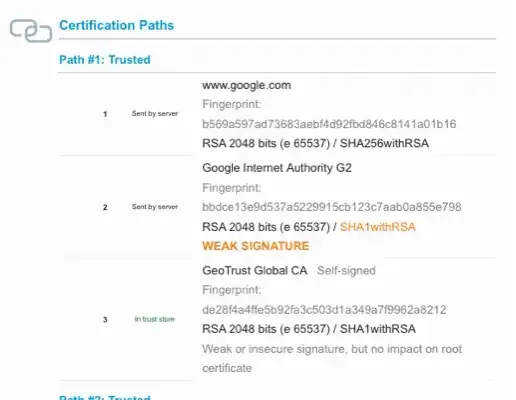Firefox dev tools shows that https://www.google.com is using a certificate signed with SHA1. Why is Google doing this when they are phasing out the certificate themselves?
Shouldn't this only hurt Google's reputation and interests?
Firefox dev tools shows that https://www.google.com is using a certificate signed with SHA1. Why is Google doing this when they are phasing out the certificate themselves?
Shouldn't this only hurt Google's reputation and interests?
This may be a case of "do what I say, not what I do". Note that Chrome complains about use of SHA-1 for signing certificates whose validity extends beyond the end of year 2015. In this case, Google's certificate is short-lived (right now, the certificate they use was issued on June 3rd, 2015, and will expire on August 31st, 2015) and thus evades Chrome's vengeful anathema on SHA-1.
Using short-lived certificates is a good idea, because it allows for a lot of flexibility. For instance, Google can get away with using SHA-1 (despite Chrome's rigorous stance) because the algorithms used to guarantee the integrity of a certificate do not need to be robust beyond the certificate expiration; thus, they can use SHA-1 for certificates that live for three months as long as they believe that they will get at least a three-month prior notice when browsers decide that SHA-1 is definitely and definitively a tool of the Demon, to be shot on sight.
My guess as to why they still use SHA-1 is that they want to interoperate with some existing systems and browsers that do not support SHA-256 yet. Apart from pre-SP3 Windows XP systems (that should be taken off the Internet ASAP), one may expect that there still linger a number of existing firewalls and other intrusion detection systems that have trouble with SHA-256. By using a SHA-256-powered certificate, Google would incur the risk of making their site "broken" for some customers -- not by Google's fault, but customers are not always fair in their imprecations.
So Google's strategy would appear to be the following:
It is a pretty smart (and somewhat evil) strategy, if they can pull it off (and, Google being Google, I believe they can).
Meta-answer/comment.
Re. Thomas' answer:
I just ran an SSL Labs scan on a Google.com server and it seems that the end entity cert is in fact SHA256withRSA. But the (single) intermediate is only SHA1withRSA. No idea why.
Screenshot:

As noted by StackzOfZtuff, the SHA1-signature is in the long-lived¹ intermediate CA «Google Internet Authority G2».
This key pair is stored in a FIPS 140-2 Level 3 certified Hardware Security Module, where it was generated.² The HSM itself is able to sign using SHA1, SHA-256, SHA-384 or SHA-512.³
However, the signature for the HSM certificate was done by GeoTrust -presumably in April 2013-, using their GeoTrust Global CA root, when it was common to use SHA-1 signatures. It would be possible to replace that signature with a SHA256 one by cross-signing by the SHA256 root and replacing the certificate sent by the server, but it hasn't been done.
Note that if an attacker was able to create a SHA-1 key colliding with Google Internet Authority, the old signature would still work,⁴ so the Intermediate CA key whould have to be revocated, and thus there may be little interest on that cross-signing path, waiting instead for the HSM replacement, which I guess is programmed to be performed within next 12 months.
¹ 05/04/2013 15:15:55 to 31/12/2016 23:59:59 GMT
² https://pki.google.com/GIAG2-CPS-1.2.pdf section 6.1.1
³ Per appendix B
⁴ Although all SHA-1 signing roots should be revoked when that becomes feasible…